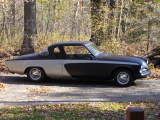I've done a search, and didnt come up with a lot of info. I also saw references to using Draino, but a search on Draino didnt come up with anything.
The bottom of the inside of my tank is covered with a black tar-like substance, and it spells like terpentine. The local radiator shop says he doesnt do gas tanks. He referred me to a place in PGH (2 hours away), but they have a 2-week turnaround, and I cant wait that long. I need it done within a couple of days.
What would be the best way to get the inside of the tank clean? Will laquer thinner remove the gunk? How is draino used to clean the tank? Any suggestions would be appreciated because I'm up against a wall here as far as time is concerned. I'll only have access to the rack for a couple more days, then the car has to be taken to the body shop. I'd like to have it back together and running while I can still use the rack, and before it has to be moved.
The bottom of the inside of my tank is covered with a black tar-like substance, and it spells like terpentine. The local radiator shop says he doesnt do gas tanks. He referred me to a place in PGH (2 hours away), but they have a 2-week turnaround, and I cant wait that long. I need it done within a couple of days.
What would be the best way to get the inside of the tank clean? Will laquer thinner remove the gunk? How is draino used to clean the tank? Any suggestions would be appreciated because I'm up against a wall here as far as time is concerned. I'll only have access to the rack for a couple more days, then the car has to be taken to the body shop. I'd like to have it back together and running while I can still use the rack, and before it has to be moved.


 [img]
[img]

Comment